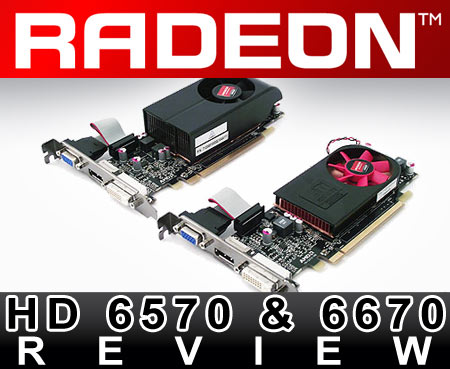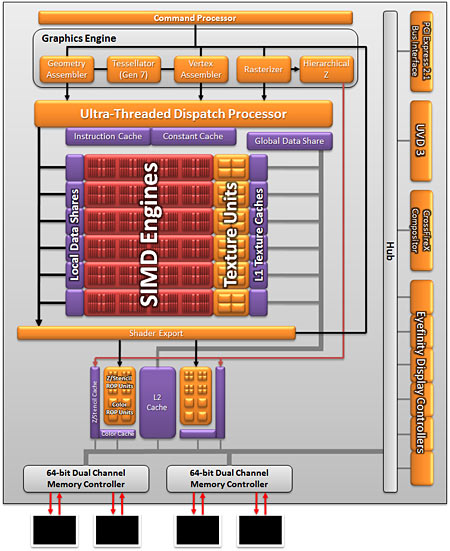AMD Radeon HD 6670 And 6570: Turkeys Or Turkish Delights?
Based on the new Turks GPU, AMD’s Radeon HD 6570 and 6670 graphics cards are poised to hit the $80-$100 market. Do these products have what it takes to compete in this fiercely competitive segment, or are AMD's subtle evolutionary changes too small?
Introducing The New Sub-$100 Radeons
For the third time this month, we’re reporting a graphics card launch from AMD. And this time it’s a double-header. Meet the Radeon HD 6570 and 6670:
These new products are a natural evolution of the Radeon HD 5570 and 5670, two very important cards in the sub-$100 graphics card market. For some time, we’ve recognized the Radeon HD 5570 as a realistic ~$65 starting point for budget buyers looking for respectable gaming hardware, and the ~$80 Radeon HD 5670 holds the distinction of being the most powerful reference design that doesn’t require a dedicated PCIe power cable.
To this point, most of the Radeon HD 6000-series cards employ a subtle (but notable) architectural tuning from the 5000-series days, so we expect these new models to be closely related to their predecessors. Let’s see how the Turks GPU stacks up:
This is another offspring of the Barts graphics processor introduced in the Radeon HD 6800 series, which itself was an evolution of Cypress. This one is scaled down to six SIMD engines, though. Each engine is associated with four texture units and is composed of 16 thread processors, with five stream processing units (ALUs) per thread processor. In the case of Turks, that makes for a grand total of 24 texture units and 480 ALUs. Two 64-bit memory controllers deliver an aggregate 128-bit memory interface, and both render back-ends host four color ROPs, totaling eight.
Turks sports the same features found across the entire Radeon 6000 line: improved tessellation performance, Eyefinity enhancements (these particular models support up to four displays), and Blu-ray 3D decode acceleration. At least for now, you'll find this GPU in two specific configurations: Radeon HD 6570 and 6670. Let’s consider where they sit in the grand scheme of things:
| Header Cell - Column 0 | Radeon HD 5570 | Radeon HD 6570 | Radeon HD 6670 | Radeon HD 5670 | GeForce GT 240 | GeForce GTS 450 |
|---|---|---|---|---|---|---|
| Shader Cores: | 400 | 480 | 480 | 400 | 96 | 192 |
| Texture Units: | 20 | 24 | 24 | 20 | 32 | 32 |
| Color ROPs: | 8 | 8 | 8 | 8 | 8 | 16 |
| Fabrication process: | 40 nm | 40 nm | 40 nm | 40 nm | 40 nm | 40 nm |
| Core/Shader Clock: | 650 MHz | 650 MHz | 800 MHz | 775 MHz | 550/1360 MHz | 783/1566 MHz |
| Memory Clock: | 900 MHz DDR3 900-1000 MHz GDDR5 | 900 MHz DDR3 900-1000 MHz GDDR5 | 1000 MHz GDDR5 | 1000 MHz GDDR5 | 850 MHz GDDR5 | 902 MHz GDDR5 |
| Memory Bus: | 128-bit | 128-bit | 128-bit | 128-bit | 128-bit | 128-bit |
| Memory Bandwidth: | 28.8 GB/s DDR3 64 GB/s GDDR5 | 28.8 GB/s DDR3 64 GB/s GDDR5 | 64 GB/s | 64 GB/s | 54.4 GB/s | 57.7 GB/s |
| Thermal Design Power Idle/Maximum (W) | 9.7/43 W | 10/44 W DDR311/60 W GDDR5 | 12/66 W | 14/61 W | 69 W Max. | 106 W Max. |
| Price | ~$65 Online | $79 (MSRP) | $99 (MSRP) | ~$80 Online | ~$80 Online | ~$115 Online |
From this chart, it's particularly clear that Radeon HD 6570 and 6670 are simple evolutionary steps from Radeon HD 5570 and 5670. Though those cards share the same specifications per SIMD engine, the new models sports six (instead of five), resulting in 80 more ALUs and four more texture units. The Radeon HD 5570 and 6570 share the same clock rates; Radeon HD 6670 gets a 25 MHz core boost over the 5670. As a result, we expect the Turks-equipped cards to demonstrate a lead over their predecessors when it comes to performance, even if the advantage isn't particularly pronounced, given the identical ROP count and 128-bit memory interface.
While we don’t expect much from the similarly-priced GeForce GT 240 (a card with lower performance than the Radeon HD 5670), the GeForce GTS 450 can be found kissing the $100 mark, promising stiff competition for the new Radeon HD 6670 and its $99 MSRP. With double the CUDA cores and ROPs of the GT 240, Nvidia's GeForce GTS 450 is a serious player. But before we see how these entry-level cards fare in combat, let’s have a look at AMD's Radeon HD 6570 and 6670 reference hardware.
Get Tom's Hardware's best news and in-depth reviews, straight to your inbox.
Current page: Introducing The New Sub-$100 Radeons
Next Page Radeon HD 6570 GDDR5 And Radeon HD 6670Don Woligroski was a former senior hardware editor for Tom's Hardware. He has covered a wide range of PC hardware topics, including CPUs, GPUs, system building, and emerging technologies.
-
jenkem price aside, i'm rather impressed with the 6670. sure the 5750 and gts 450 are more powerful, but nvidia's card just looks ridiculous in the power draw graph. being the fastest card without a pci-e connector is more than just a title, the 6670 will become the new go-to card for people with dells, hps, and ect looking to upgrade to discrete graphics(like the 4670 and 5670 before it).Reply
also, a 5670 can be found on newegg for $73 before rebate. -
4745454b With $99 after MIR 5770s on newegg, the GTS450, 5750, and 6670 are all to expensive. I am most impressed that AMD has got this level of performance out ofReply -
Nintendork The card has great overclock:Reply
960Mhz+ / 5000+Mhz for the memory. A 21% increase in games (tpu review). -
fatkid35 i used to play cod4 with a 3.0 ghz dual core and a radeon 4650 @ 1400x900 with good frame rates. and the whole pc only had a draw of 135 watts at the wall. this new 6670 is a kick @ss low power solution for most wanting to game on the semi cheap. kinda want one for my back up pc now.Reply -
enzo matrix For $80, how can you beat a card that can overclock to 6670 speeds easily? And perform identically due to the same specs otherwise?Reply -
jestersage great review!Reply
just wondering why we used a 1200w psu when most systems use only 10% of its capacity... i believe the power draw graphs are skewed due to lower efficiency at that load. -
mognet jestersagegreat review!just wondering why we used a 1200w psu when most systems use only 10% of its capacity... i believe the power draw graphs are skewed due to lower efficiency at that load.Reply
Its just standard practise to overkill all other components to make sure they don't cause weird results. Besides the absolute draw isn't important its how the cards compare with each other.

